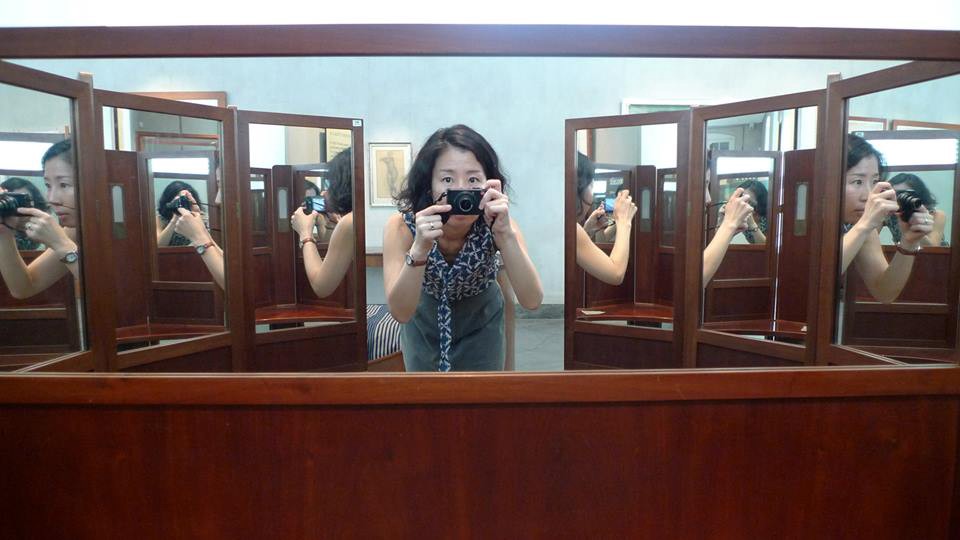Porcelain, Lacquer, Hardwood
Kyoungjin Bae and the secret life of eighteenth-century Chinese furniture

Remember Mo Pareles from a few Lab Reports back? Her wife Nicole has a brother named Jon, and Jon has a partner named Kyoungjin Bae. She, like the rest of them, is a genius; I thought you might like to meet her.
Bae got her PhD in History from Columbia in May this year. She moved to the US for grad school, from South Korea where she majored in history and minored in education at Yonsei University in Seoul. She began grad school there, specializing in early modern European history. But trans-regional history (think: interdisciplinary international relations of the past) drew her in, and she decided to specialize. Bae went on to a doctorate in the international-global history track at Columbia, where she became interested in the cross-cultural history of early modern China and Britain.
She’s the kind of historian who is interested most by objects, although professionals call it material culture. Bae is currently working on a co-authored article about the financial system of the imperial palace workshops during the Qing dynasty (the last imperial dynasty of China, in power approximately 1614–1912). Her dissertation is about the history of Chinese furniture produced and exported for the European market in the eighteenth century. It’s called “Joints of Utility, Crafts of Knowledge: the Material Culture of the Sino-British Furniture Trade during the Long Eighteenth Century.”

In the beginning of the eighteenth century, furniture made in Canton (present-day Guangzhou), China, became a big hit export to Europe. Chinese exports were no new thing, of course — porcelain had been manufactured for European export since the 16th century — but this furniture was crafted out of hardwoods from the Indian Ocean and produced in European designs. It was often, Bae told me when we spoke recently, “indistinguishable from its Western counterparts.”
Previous scholars studying Chinese export objects, Bae said, have mostly “focused on European reception through the lens of exoticism.” Chinese products in European culture have often interested historians for their Chineseness, their difference to the material surroundings within which they found themselves.
By focusing on export furniture, Bae wants to “complicate our understanding of Sino-European exchanges.” If a dresser or a chair came from one place, and doesn’t look like it did, but undoubtedly lived a material life in a different place, what can that object tell us about the world that made it? (I’m speaking for Bae here; historians don’t put things so crudely.) This puts me strangely in mind of ersatz goods, the late twentieth-century stereotype of Chinese-manufactured products that imitate American plastics or fashion. The objecthood of this eighteenth-century furniture was nothing like the “knockoff” products of today. The material nature of the goods is different; it insists that we pay attention to its historical truth.
Bae follows the stories of Chinese export furniture “from its origins in the intra-Asian timber trade to its requisition and manufacture in Canton to its reception and use in Britain, highlighting how this process linked the disparate spheres of commerce, decorative arts, and natural science.” These objects turned local practice into global products; they drew processes and histories and other things into their orbit. Object histories show connections the way that a diagram of the solar system shows planetary routes that are invisible in the night sky.
Bae argues that export furniture can be interpreted as a transnational Eurasian object that “embodied cross-cultural knowledge of craft and nature and engendered new ideas of utility and sociability in both China and Britain.” History is made out of ordinary things more often than it is upended by extraordinary events: studying material culture grants us an audience with a bygone “normal” that is forever lost to those who only study revolutions.

Bae wants to figure out how to “incorporate the unspoken, unwritten bodily aspects of historical experiences into the study of history.” How have the body and material things “co-produced distinctive cultural patterns in the past”? For example: how, say, did craftspeople “use their own bodies and external materials — tools, ingredients, and workshop environments — to make things?” And why did people in the past “sit, sleep, and organize their desks and wardrobes in the ways they did?”
These kinds of questions raise procedural challenges of their own, giving rise to disciplinary challenges for researchers like Bae. To answer them, a historian must “connect divergent methods and perspectives from history, art history, anthropology, ergonomics, and STS [Science, Technology, and Society].” It’s important to Bae that she do this kind of study in a trans-cultural context. The dissertation was about Sino-European interactions, but in the future she wants to look at Sino-Korean exchanges, too.
Nowadays, we are now connected to each other in a way that feels barely related to space, or place. In Bae’s words, “the everyday life of ordinary people in one country is directly or indirectly connected to that of people in other countries.” Technology makes us especially aware of these connections, and that awareness grows in intensity every day. Bae believes we need to find “a deeper degree of mutual understanding,” to protect and develop certain “socio-cultural values that we as human beings can all respect and cherish.”
Kyoungjin Bae has a great “affinity for objects,” she told me, that has been “deeply woven” into the way she does history and research. She goes to see them at auctions, private galleries, museum warehouses, galleries — and she feels that an audience with objects is a privilege and a luxury. “What more could I aspire to in order to realize my childhood dream to be with objects?” she said. She deserves it all; the objects deserve her, too. Call me a sucker for a historian with a political conscience, but I find Bae’s dedication to old chairs and tables in the service of a new emotional understanding of globalization extremely moving.
Josephine Livingstone is an academic and writer in New York.
